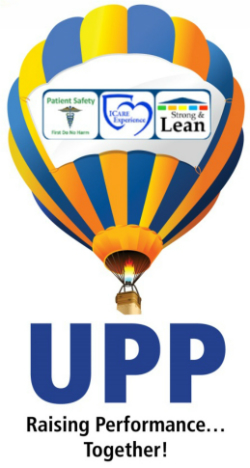Your Care Team: Committed to Nonstop Improvement
What if, every single day, hospital care was being reimagined so that it was just a little bit better?
A little bit safer? A little more logical? What if it were designed in ways that so clearly showed we had our patients’ biggest (and smallest) concerns in mind, right from the start?
What could that look like?
These exciting questions are being asked—and answered—in hundreds of ways across Strong Memorial’s 41 inpatient units.
For Strong’s Labor and Delivery Unit, nurse manager Barb Maier, R.N., says this commitment to better care has meant that more C-section patients are being empowered to breastfeed their babies sooner after birth.
 “We know these mothers are exhausted,” Maier says. “But we also know the science is convincing: breast milk is best, and getting babies to nurse as soon as possible is a great way to promote bonding, maintain a newborn’s temperature, and keep their blood sugar stable.”
“We know these mothers are exhausted,” Maier says. “But we also know the science is convincing: breast milk is best, and getting babies to nurse as soon as possible is a great way to promote bonding, maintain a newborn’s temperature, and keep their blood sugar stable.”
But those first hours after the cesarean bring a flurry of activity for tired moms recovering in the PACU (Post Anesthesia Care Unit). That’s why Labor and Delivery (and the rest of Strong’s OB nursing service) recently amped up its existing nurse education so that they could, in turn, better support these mothers as breastfeeding advocates. According to OB nurse educator Maureen Freedman, RNC, IBCLC, it’s a two-pronged approach.
“We’re providing updated instruction to veteran staff,” Freedman says. “But we’re also educating all new nurses with a 20-hour breastfeeding course.” Offered quarterly by the OB lactation consultants, the course includes an online component, an 8-hour classroom training, and a practicum during which nurses work directly with a lactation consultant on the inpatient units.
“We’re a busy unit,” Maier admits. “But we’re trying hard to be proactive, and to really encourage these moms in their breastfeeding experience. We’ll even hold the baby for them while they are nursing, if that’s what it takes.”
Since fall 2013 (before the unit ratcheted up its focus helping these moms nurse), samplings of patients showed that 63 percent of cesarean patients were nursing within two hours of delivery. But in the same quarter, just a year later? Thanks to the breastfeeding course, staff education, and regular communiqués (meeting and e-mail) underscoring the initiative’s import, that number climbed to 80 percent.
UPP means ‘continuous improvement’
 Our Labor & Delivery team’s commitment to helping moms nurse soon after surgery is just one example of the more than 100 care improvement projects cropping up across the hospital, thanks to UPP—Strong Memorial’s Unit-based Performance Program. The program, which formally launched in fall 2013, trains frontline caregivers to suggest, develop, and implement projects that are tailored to improving care on their units.
Our Labor & Delivery team’s commitment to helping moms nurse soon after surgery is just one example of the more than 100 care improvement projects cropping up across the hospital, thanks to UPP—Strong Memorial’s Unit-based Performance Program. The program, which formally launched in fall 2013, trains frontline caregivers to suggest, develop, and implement projects that are tailored to improving care on their units.
According to Strong Memorial Associate Quality Officer Pat Reagan Webster, Ph.D., UPP is modeled on a safety program borrowed from Johns Hopkins. Our adaptation at Strong, however, goes a few steps further. We’re looking at care quality more holistically—and that means going beyond our ever-better approach to safety and also focusing on improving our overall culture (making it more patient- and family-centered) and unearthing new efficiencies (we’re eager to curb waste and make care more seamless).
“This program reinforces the idea that continuous improvement is everybody’s job,” Reagan Webster says. “That means the whole care team—everyone from the nurse for your shift to the resident you meet during rounds—is being held responsible for figuring out how to deliver safer, smarter, more compassionate care. It’s just how we’re starting to approach our work.”
And now: Some impressive numbers
Tracking this kind of improvement in hard numbers is super important—and also, pretty exciting.
“Everything about our UPP model is data-driven,” Reagan Webster says. “We aren’t looking for a bunch of soft successes or anecdotes.”
To that end, UPP champions from each unit attend quarterly meetings to share victories and percolating ideas. Recent results from the December 2014 leader meeting offer a snapshot of UPP’s recent successes:
-
By showing sharper attention to hand hygiene, environmental cleaning, and consistent antibiotics use, our Surgical Oncology unit (WCC5) cut the incidence of C. diff (a dangerous GI infection too common in healthcare settings) by 36 percent in one year.
-
By implementing a standard discharge checklist, our 6-1600 General Medicine unit is now able to get patients back to their homes sooner. They’ve reduced the number of late-day (post 4 p.m.) discharges by 17 percent.
-
By conducting more routine rounding, our 4-3600 Pediatric General Care unit was able to score 90 percentile or better in five out of six satisfaction domains tracked by Press Ganey.
-
By implementing a more visible vaccine tracking log and a new system of checks and double-checks, our 1-9200 Behavioral Medicine unit made big leaps immunizing its patients against flu this winter—vaccination rates now consistently hover between 98 to 100 percent.
“All of these are remarkable,” Reagan Webster says. “But what’s even more exciting is that we’re starting to see proof of some ideas spreading.”
 For instance, a new discharge lounge for cancer patients is helping to free up beds for new patients and others have been cleared to head home, but maybe are awaiting rides. The discharged patients can relax with coffee, enjoying a book or TV, all with a nurse available right in the room. It’s a concept borrowed from a med-surg service, and it seems to be translating beautifully in the Cancer Institute.
For instance, a new discharge lounge for cancer patients is helping to free up beds for new patients and others have been cleared to head home, but maybe are awaiting rides. The discharged patients can relax with coffee, enjoying a book or TV, all with a nurse available right in the room. It’s a concept borrowed from a med-surg service, and it seems to be translating beautifully in the Cancer Institute.
Similarly, the 5-3400 Orthopaedics unit recently created a series of videos to brief patients on what they can expect during their stays. After seeing the videos at a leader meeting, Strong’s Pediatrics department decided to create a similar series of patient and family education for when its new children’s hospital opens.
“The results from UPP have been overwhelmingly encouraging,” Reagan Webster says. “At some point, we hope to expand the improvement program to our outpatient services.”
4/10/2015
You may also like